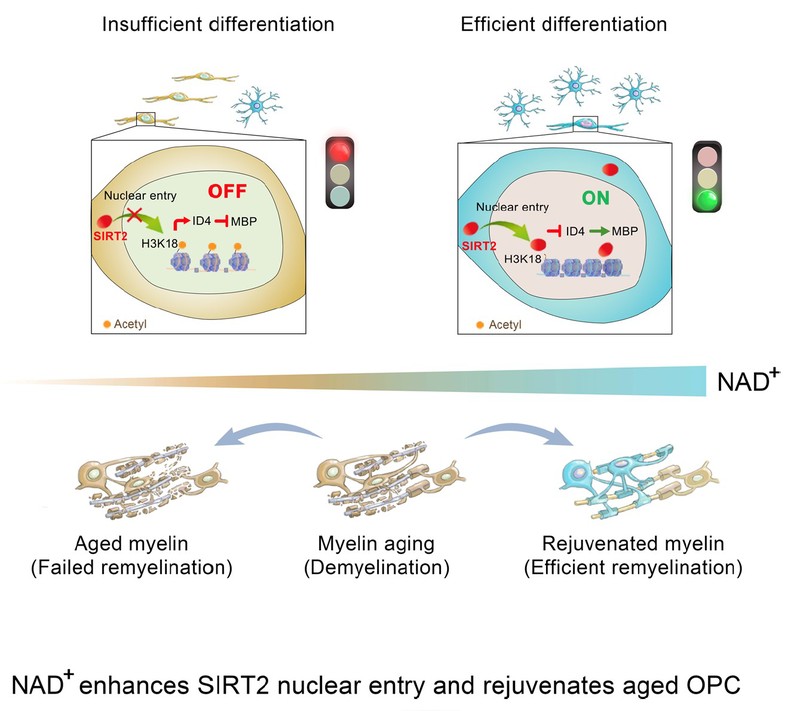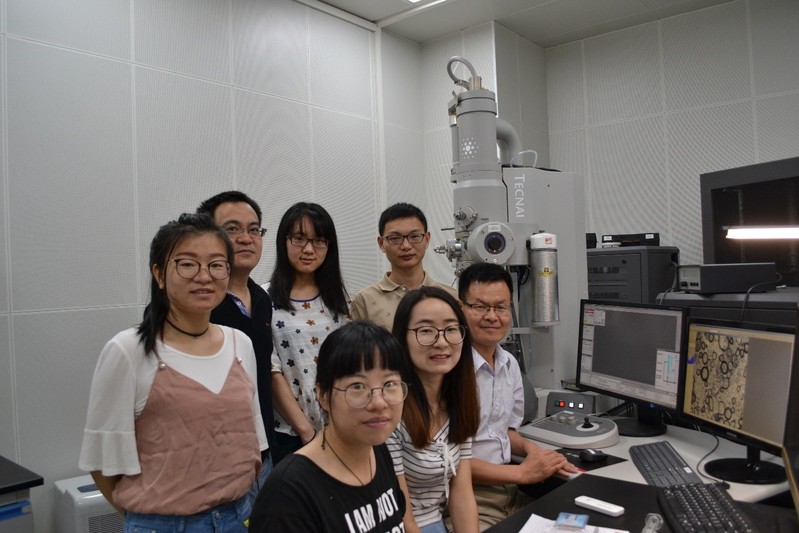Myelin is a multiple-layered structure formed by oligodendrocytes. The ensheathment of axons by myelin plays an important role in both functional integrity and long-term survival of axons and thus regulates activity of the central nervous system (CNS). However, with ageing, some myelin sheaths exhibit myelin ageing and even myelin degeneration termed as demyelination, which is the key pathological feature of the autoimmune inflammatory diseases of CNS such as multiple sclerosis (MS) and an early pathological hallmark of neurodegenerative diseases. Also, myelin repair termed as remyelination by oligodendrocytes which are differentiated from oligodendrocyte progenitor cells (OPCs) occurs throughout life. Unfortunately, with ageing, the efficiency of remyelination declines mainly due to the reduced capacity of OPC differentiation. Therefore, identifying new molecular targets in OPCs to rejuvenate the aged OPCs holds the key to promote remyelination.
Recently, the research group led by Prof. ZHAOJingwei at the Zhejiang University School of Medicine, in collaboration with Prof. CHEN Houzao at Chinese Academy of Medical Sciences & Peking Union Medical College, Prof. SHU Yousheng at Beijing Normal University, and JU Zhenyu at Jinan University, published an article entitled “Restoring nuclear entry of Sirtuin 2 in oligodendrocyte progenitor cells promotes remyelination during ageing” in the journal Nature Communications.
Firstly, the study showed that SIRT2 is expressed in postnatal OPCs but the nuclear localization of SIRT2 in OPCs during remyelination declines during ageing. Using SIRT2 knock mice they showed that SIRT2 is critical for remyelination. Furthermore, the study revealed that NAD+ was one of the top metabolites that significantly decreased in the aged OPCs obtained from telomerase deficiency early ageing mice. Elevating NAD+ by β-NMN, the immediate precursor of NAD+, enhances SIRT2 nuclear entry in OPCs and promotes OPCs differentiation. They further showed that in vivo NAD+supplementation not only prevents but also treats the demyelination and enhances remyelination efficiency in the CNS of the aged mice to the level of the young mice both structurally and functionally, highlighting the therapeutic effect of β-NMN on demyelination diseases in the old animals.
Finally, the study clearly dissected the molecular mechanisms underlying the effects of NAD+: aged OPCs are depleted in SIRT2 nuclear localization and have less NAD+. Supplementation of β-NMN elevates the NAD+ level, restores nuclear entry of SIRT2 in the aged OPCs and deacetylates H3K18, thus suppressing the transcription of ID4 and further promoting OPCs differentiation, and eventually delays myelin ageing in the normal CNS and enhances myelin repair in the demyelinated aged CNS (See the Schematic Figure).

“Our work demonstrates that β-NMN not only delays myelin ageing in normal, but also enhances myelin repair in diseased conditions,” Dr. MA Xiaoru, one of the first authors, says. “This study found β-NMN as a new small molecule for myelin ageing, and more importantly, identified SIRT2 as a new target for oligodendrocyte lineage cells, paving the way for future clinical translation study on demyelination and neurodegenerative diseases,” Prof. ZHAO Jingwei further states.

The first author MA Xiaoru (middle in the front line) and the corresponding author Prof. ZHAO Jingwei (front line, the first on the right)
More information: PhD student MA Xiaoru (now postdoctoral fellow) and Prof. ZHU Xudong are the co-first authors of this article. Prof. ZHAO Jingwei, Prof. JU Zhenyu, Prof. SHU Yousheng and Prof. CHEn Houzao are the co-corresponding authors of this article.
Source and Photo credit: the research team led by Prof. ZHAO Jingwei